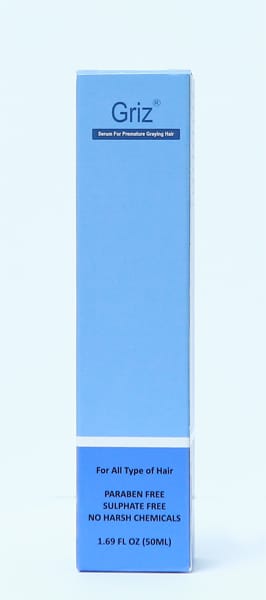Int J Trichology
2013 Jan; 5(1):17-21.10.4103/0974-7753.114706.
Epidemiological and investigative study of premature graying of hair in higher secondary and pre-university school children
Ramesh M Bhat 1, Rashmi Sharma, Anita C Pinto, SukumarDandekeri, JacinthaMartis
Abstract
Background: Hair pigmentation is one of the most conspicuous phenotypes in humans ranging from black, brown, and blonde to red. Premature graying of hair occurs more commonly without any underlying pathology but is said to be inherited in autosomal dominant pattern. Premature graying has been shown to be associated with a few of the autoimmune disorders. A role for environmental factors and nutritional deficiencies has also been postulated. However, to date the exact etiology of premature graying has not been established.
Aim: The objective of our study was to conduct an epidemiological and investigative study of premature graying of hair in higher secondary and pre-university school children of the semi-urban area.
Materials and methods: A total of 35 cases and controls were investigated for various parameter such as Hemoglobin, total iron binding capacity, serum ferritin (S. Ferritin), serum calcium (S. Ca), serum iron (S. Iron), vitamin B12, and vitamin D3 after taking informed consent. Epidemiological and investigations correlation was established using the Chi-square and Mann Whitney test and P < 0.05 values were considered significant.
Result: Among the various laboratory parameters S. Ca, S. Ferritin and vitamin D3 were low in patients with premature graying of hair. There was significant high number of vitamin D3 deficient and insufficient among the cases compared to the controls.
Conclusion: According to our study S. Ca, S. Ferritin, vitamin D3 may play a role in premature graying of hair in our society.
HAIR AND NAIL DISORDERS| VOLUME 68, ISSUE 4, SUPPLEMENT 1, AB108, APRIL 2013
Premature graying of scalp hairs treated with ferrous sulfate
DOI:https://doi.org/10.1016/j.jaad.2012.12.446
Journal of American Academy of Dermatology
Hair graying (canities) is a natural age-associated process. Premature hair graying is defined as gray hair onset before the age of 20 in whites, 25 in Asians, and 30 in African Americans.
While premature canities more commonly appear without underlying pathology, it has also been associated with a similar cluster of autoimmune disorders. An 11-year-old Korean male presented with 1-year history of hair graying on the scalp.
Hair examination revealed normal black and white color bands alternating in same hair shaft. On the laboratory test, hemoglobin and ferritin level were 8.4 g/dL, and 2.6 ng/mL, respectively.
It was consistent with clinical diagnosis of iron deficient anemia. We treated with iron supplements including ferrous sulfate for 5 months. After treatment, his hair color recovered to nearly normal black color.
Herein, we report a patient who had premature hair graying treated with iron supplements including ferrous sulfate.
Journal of the American Academy of Dermatology
Volume 72, Issue 2, February 2015, Pages 321-327
Objective: This study aimed to identify risk factors for premature hair graying (PHG) in young men.
Methods:
We conducted a cross-sectional study using questionnaires in young men. After a pilot study that included 1069 men, we surveyed 6390 men younger than 30 years about their gray hair status and various socioclinical characteristics.
Results:
The age of participants in the main survey was 20.2 ± 1.3 years (mean ± SD). Of the 6390 participants, 1618 (25.3%) presented with PHG.
Family history of PHG (odds ratio [OR], 12.82), obesity (OR, 2.61), and >5 pack-years history of smoking (OR, 1.61) were significantly associated with PHG. In the multivariate analysis, family history of PHG (OR, 2.63) and obesity (OR, 2.22) correlated with the severity of PHG.
Limitations:
Owing to the use of questionnaires, the possibility of recall bias exists. Women were not evaluated in this study.
Conclusion
Smoking, family history of PHG and obesity are important factors associated with PHG.
Anna Cooper
Sun 26 Jan 2020
The five: factors that affect early greying
This article is more than 4 years old
As researchers confirm that stress can turn you grey, we look at the other scientific factors that could salt-and-pepper your crowning glory
 Avoid stress
Avoid stress
This week, scientists from Harvard demonstrated that stress can accelerate the greying of human hair. The researchers found that stress prompts the production of a hormone that affects the melanocyte cells involved in making hair pigments. The scientists hope that this discovery will add to the understanding of how the depletion of stem cells contributes to ageing in general.
French secret agents
Scientists have long known that the reservoir of melanocyte cells is key to pigment production. A group of French scientists have developed agents that mimic the action of a naturally occurring enzyme that protects the cells. They are working on commercializing the product but if successful it would prevent greying, rather than reversing it.
The genetic aspect
Premature greying can be caused by autoimmune diseases such as vitiligo and alopecia areata. Premature ageing syndromes, where all aspects of ageing are sped up, such as Hutchinson-Gilford progeria and Werner syndrome also result in greying. Genes are thought to regulate greying, but scientists have yet to identify those responsible.
Positive side-effects
A study by the Autonomous University of Barcelona revealed that a side-effect of new immunotherapy drugs is that they may restore hair pigment. Out of 52 lung cancer patients in the research, 13 found their grey hair darken to brown or black and one patient experienced color in patches, as a result of the drugs. They also found that 13 of these 14 responded better to the cancer treatment.
Grey heirs?
Smoking, obesity and a family history of going grey early all contribute to premature greying. Those with a paternal history of early grey are most at risk, according to the Journal of the American Academy of Dermatology.
A Case of Premature Hair Graying Treated with Ferrous ...
Annals of Dermatology
https://anndermatol.org › DOIx
by JW Choi • 2016 • Cited by 5 — A lot of pathologic conditions have been discussed about the association with a premature
canities such as hypothyroidism, vitamin B12


